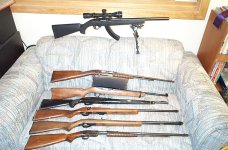The Marlin 60 is the old Marlin 99.
Same rifle as the Glenfield 60.
The Marlin Model 99C was mfg'd for the longest time. From 1961 to '78.
This is the most commonly seen 'version'.
The original Model 99 (no letter suffix) was only made for a couple yrs... '59 to '61
The Marlin 99 and Glenfield 60 were made at the same time.
The Glenfield outsold the Marlin branded rifle.
When Marlin dropped the Glenfield line all together, they took the 'Model 60' from the Glenfield and tacked it onto the Marlin 99,,making the Marlin rifle the Marlin Model 60.
The 60's and early 70's Model 99 Marlin and 60 Glenfield was plagued with ejector problems.
The ejector was a cast-in-place projection on the sintered metal feed throat. . That ejector tip wore off very quickly on some batches of feed throats,,which were outside sourced by Marlin.
Many of the rifles couldn't make it through a Range trip w/o FTEject problems.
They used to come back in on warantee for repair by the pallet from BigBoxStores and FailtoEject was the usual reason.
In the early 70's a Repair Dept employee came up with the idea of using the un-used end of the torsion spring powering the cartridge lifter as the ejector. Instead of that end of the spring simply being bent and captured in the sideplate of the action under the recv'r, he made an extra long spring that wrapped around and came up and over the feed throat. Then sat in a groove filed in the old usually worn out ejector tip.
The blunt end of the spring wire was now the ejector point.
His hand made spring and fashioned ejector rifle ran around 50k rds through it w/o an ejection or feed problem in the range..
Marlin adopted the idea for the Model 99 some time later in the 70's and used it ever since then. It really saved that rifle.
The employee submitted the idea early on in one of those '$$ for ideas' plans that most factorys had then.
Clearly his idea, but got nothing for it. He was told that R&D had already thought of the idea and plans were in the works to make the mfg'ing change.
The bolt buffer in the back of the action breaks down quite often. Many just from age, they get brittle and crack. A few shots and they crumble and splinter to pieces.
If you pull the bbl'd action assembly out of the wood and there's little splinters and pieces of white or an off-yellow plastic down in the wood inlet near the back,,that stuff is the remnants of the bolt buffer.
Replacement s are generally available from places like Brownells. The Factory replacements were just that, no better than the one used to assemble the rifle and they'd last a few years and then break.
I used to make then from Delrin (sp?) and they lasted OK.
Kind of overkill I guess, but they held together.
To replace them you have to take the action off of the bottom of the alloy frame. That's easy enough.
Then you have to remove one side plate to be able to lift the buffer from the assembly.
The cross pins holding the side plates together are(were?) locked together with tiny C clips.
Most important thing is to place a bent paperclip thu the mainspring follower of the hammer spring and then trip the sear and let the hammer forward till the paperclip holds the mainspring secure against the mainspring strut.
(Kind of like taking a Ruger SAA mainspring out.)
Otherwise things fly away when you pull the side plate off...
If you remove the bolt from the recv'r, make sure you don't kink the long smal dia recoil spring when reassembling it.
Make use of the recoil spring guide rod to help slide the spring back in place.
Many do have a kink in them from hasty reassembly and still function OK. But it can play hell on extraction/ejection with some ammo especially StdVel.
The older ones didn't have a last shot bolt hold open,,I think the 'newer' ones do. Seems like one my brother had did. It was from the 80's some time. That's 'newer' in my book!
Those older mfg did have a manual bolt hold open.
Pull the bolt back and push the charging handle in and it holds the bolt open. Handy for cleaning, inspection and range etiquette.
I always think about the hundreds and more of these and Model80 series bolt 22's we destroyed because they didn't have ser#'s on them.
Sent in from those retail outlets on warantee exchanges. The customers had already gotten a new rifle in exchange. These were pre 68 mfg rifles with no ser#'s. It was now post 68.
The rifles at first were rebuilt/repaired and a new ser# stamped on them per ATF OK. Then it was decided it wasn't worth the effort. So those unser#'d rifles would be stripped for their parts, the parts refinished and the recv'rs destroyed. Then that was too much effort and time.
So the entire rifles were simply sawed into pieces and disposed of.
It's always a matter of $$. Sometimes a couple pennys one way or the other.



